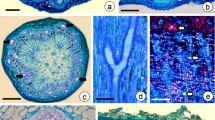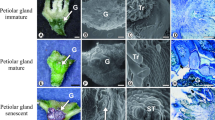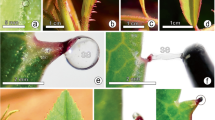Abstract
This study investigates the histology and subcellular features of secretory cavities during the development of the shoot apex of Metrodorea nigra A. St.-Hil. in order to better understand the functioning of these glands. This Rutaceae species is a very suitable model for studying secretory cavity life span, since the shoot apex exhibits both dormant and growth stages during its annual cycle. Shoot apices were collected during the dormant and growth stages from populations of M. nigra growing under natural conditions. Materials were processed using standard techniques for light and electron microscopy. The secretory cavities originate under the protodermis, and their initiation is restricted to the early developmental stage of shoot organs, which are protected by a hood-shaped structure. Secretory cavities have a multi-seriate epithelium surrounding a lumen that expands schizolysigenously. Oil production begins before lumen formation. When the shoot apex resumes development after the dormant stage, the glands remain active in oil secretion in the developing shoot apex and fully expanded leaves. The mature epithelial cells are flattened and exhibit very thin walls, large oil bodies, leucoplasts surrounded by endoplasmic reticulum, and mitochondria with unusual morphology. The tangential walls of the epithelial cells facing the lumen undergo continuous peeling. The vacuole extrusion appears to be the primary mode of release oil into the lumen, in an exocytotic way. The continuity of oil secretion is ensured by the replacement of the damaged inner epithelial cells by divisions in the parenchyma layer that surround the oil gland, likely a meristematic sheath.







Similar content being viewed by others
References
Bennici A, Tani C (2004) Anatomical and ultrastructural study of the secretory cavity development of Citrus sinensis and Citrus limon: evaluation of schizolysigenous ontogeny. Flora 199:464–475
Bosabalidis A, Tsekos I (1982a) Ultrastructural studies on the secretory cavities of Citrus deliciosa Ten. I Early stages of the gland cells differentiation. Protoplasma 112:55–62
Bosabalidis A, Tsekos I (1982b) Ultrastructural studies on the secretory cavities of Citrus deliciosa Ten. II Development of the essential oil–accumulating central space of the gland and process of active secretion. Protoplasma 112:63–70
Braga MR, Dietrich SMC (1987) Defesas químicas de plantas: fitoalexinas. Acta Bot Bras 1:3–16
Burt S (2004) Essential oils: their antibacterial properties and potential applications in foods—a review. Int J Food Microbiol 94:223–253
Canaveze Y, Machado SR (2015) Leaf colleters in Tabernaemontana catharinensis A.DC. (Apocynaceae, Rauvolfioideae): structure, ontogenesis and cellular secretion. Botany 93:287–296
Carr DJ, Carr SGM (1970) Oil glands ducts in Eucalyptus l’Hérit. II. Development and structure of oil glands in the embryo. Aust J Bot 18:191–212
Chen Y, Wu H (2010) Programmed cell death involved in the schizolysigenous formation of the secretory cavity in Citrus sinensis L. (Osbeck). Chin Sci Bull 55:2160–2168
Cruz R, Duarte M, Pirani JR, Melo-de-Pinna GFA (2015) Development of leaves and shoot apex protection in Metrodorea and related species (Rutaceae). Bot J Linn Soc 178:267–282
Cunha AR, Martins D (2009) Classificação climática para os municípios de Botucatu e São Manuel–SP. Irriga 14:1–11
David R, Carde JP (1964) Coloration differentielle dês inclusions lipidique et terpeniques des pseudophylles du pine maritime au moyen du reactif Nadi. C R Acad Sci Paris, Série D 257:1338–1340
Deng Y, Kohlwein S, Mannella CA (2002) Fasting induces cyanide-resistant respiration and oxidative stress in the amoeba Chaos carolinensis: implications for the cubic structural transition in mitochondrial membranes. Protoplasma 219:160–167
Epand RF, Martinou J-C, Fornallaz-Mulhauser M, Hughes DW, Epand RM (2002) The apoptotic protein tBid promotes leakage by altering membrane curvature. J Biol Chem 277:32632–32639
Esau K (1965) Plant anatomy. Wiley, New York
Evert RF (2006) Esau’s plant anatomy, meristems, cells, and tissues of the plant body—their structure, function, and development. Wiley, New Jersey
Fahn A (1979) Secretory tissues in plants. Academic Press, London
Feder N, O’Brien TP (1968) Plant microtechnique: some principles and new methods. Am J Bot 55:123–142
Figueiredo AC, Pais MS (1994) Ultrastructural aspects of glandular cells from the secretory trichomes from the cell suspension cultures of Achillea millefolium L. ssp. millefolium. Ann Bot 74:179–190
Guidugli MC, Ferreira-Ramos R, de Sousa ACB, Cidade FW, Marconi TG, Mestriner MA, Groppo M, Alzate-Marin AL (2012) Genetic diversity of Metrodorea nigra (Rutaceae) from a small forest remnant in Brazil assessed with microsatellite markers. Genet Mol Res 11:10–16
Haberlandt G (1914) Physiological plant anatomy. Macmillan, London
Harborne JB (1997) Biochemical plant ecology. In: Dey PM, Harborne JB (eds) Plant biochemistry. Academic Press, London, pp. 503–516
Hayat MA (1989) Principles and techniques of electron microscopy: biological applications. CRC Press, Boca Raton
Heinrich G (1966) Licht-und elektronenmikroskopische Untersuchungen zur Genese der Exkrete in den lysigenen Exkreträumen von Citrus medica. Flora 156A:451–456
Heinrich G (1969) Elektronenmikroskopische Beobachtungen zur Entstehungsweise der Exkretbehälter von Ruta graveolens, Citrus limon und Poncirus trifoliata. Oesterr Bot Z 117:397–403
Jensen WA (1962) Botanical histochemistry: principles and practice. W. H. Freeman and Company, San Francisco
Jin XL, Du YQ (2002) Advance in study on cultivation and management of bergamot. Spec Wild Eco Animal Plant Res 2:48–55
Johansen DA (1940) Plant microtechnique. McGraw–Hill, New York
Judd WS, Campbell CS, Kellogg EA, Stevens PF, Donoghue MJ (2008) Plant systematics: a phylogenetic approach. Sinauer Associates Inc., Sunderland, Mass
Kalemba D, Kunicka A (2003) Antibacterial and antifungal properties of essential oils. Curr Med Chem 10:813–829
Knight TG, Klieber A, Sedgley M (2001) The relationship between oil gland and fruit development in Washington navel orange (Citrus sinensis L. Osbeck). Ann Bot 88:1039–1047
Lange BM, Turner GW (2013) Terpenoid biosynthesis in glandular trichomes-current status and future opportunities. Plant Biotechnol J 11:2–22
Liang SJ, Wu H, Lun X, Lu DW (2006) Secretory cavity development and its relationship with the accumulation of essential oil in fruits of Citrus medica L. var. sarcodactylis (Noot.) Swingle. J Integr Plant Biol 48:573–583
Liang S, Wang H, Yang M, Wu H (2009) Sequential actions of pectinases and cellulases during secretory cavity formation in Citrus fruits. Trees 23:19–27
Liu P, Liang S, Yao N, Wu H (2012) Programmed cell death of secretory cavity cells in fruits of Citrus grandis cv. Tomentosa is associated with activation of caspase 3-like protease. Trees Struct Funct 26:1821–1835
Machado SR, Guimarães EM, Gregório EA (2006) Ovary peltate secretory trichomes of Zeyheria montana (Bignoniaceae): developmental ultrastructure and secretion in relation to function. Ann Bot 97:357–369
Mandalari G, Bennett RN, Bisignano G et al (2007) Antimicrobial activity of flavonoids extracted from bergamot (Citrus bergamia Risso) peel, a byproduct of the essential oil industry. J Appl Microbiol 103:2056–2064
Mannella CA (2006) Structure and dynamics of the mitochondrial inner membrane cristae. Biochim Biophys Acta 1763:542–548
Mazia D, Brewer PA, Alfert M (1953) The cytochemical staining and measurement of protein with mercuric bromophenol blue. Biol Bull 104:57–67
Milani JF, Rocha JF, Teixeira SP (2012) Oleoresin glands in copaiba (Copaifera trapezifolia Hayne: Leguminosae), a Brazilian rainforest tree. Trees 26:769–775
Moraes Filho RM, Bonifácio-Anacleto F, Alzate-Marin AL (2015) Fragmentation effects and genetic diversity of the key semidecidual forest species Metrodorea nigra in Southwestern Brazil. Genet Mol Res 14:3509–3524
O’Brien TP, Feder N, McCully ME (1964) Polychromatic staining of plant cell walls by toluidine blue. Protoplasma 59:368–373
Oliva A, Di Blasio B, Cafiero G, Aliotta G, Iacovino R, DeFeo V (2000) Allelochemicals from rue (Ruta graveolens L.) and olive (Olea europaea L.) oil mill waste waters as potential natural pesticides. Curr Top Phytochem 3:167–177
Paiva EAS, Oliveira DMT, Machado SR (2008) Anatomy and ontogeny of the pericarp of Pterodon emarginatus Vogel (Fabaceae Faboideae) with emphasis on secretory ducts. A Acad Bras Ciênc 80:455–465
Pombal ECP, Morellato LPC (2000) Differentiation of floral color and odor in two fly pollinated species of Metrodorea (Rutaceae) from Brazil. Plant Syst Evol 221:141–156
Possobom CCF, Guimarães E, Machado SR (2015) Structure and secretion mechanisms of floral glands in Diplopterys pubipetala (Malpighiaceae), a neotropical species. Flora 211:26–39
Regnault-Roger C (1997) The potential of botanical essential oils for insect. Integr Pest Manag Rev 2:25–34
Reynolds ES (1963) The use of lead citrate at high pH as an electron-opaque stain in electron microscopy. J Cell Biol 17:208
Rodrigues TM, Machado SR (2012) Oil glands in Pterodon pubescens Benth.(Leguminosae-Papilionoideae): distribution, structure, and secretion mechanisms. Int J Plant Sci 173:984–992
Rodrigues TM, Teixeira SP, Machado SR (2011a) The oleoresin secretory system in seedlings and adult plants of copaíba (Copaifera langsdorffii Desf., Leguminosae-Caesalpinioideae). Flora 206:585–594
Rodrigues TM, Santos DC, Machado SR (2011b) The role of the parenchyma sheath and PCD during the development of oil cavities in Pterodon pubescens (Leguminosae–Papilionoideae). C R Biol 334:535–543
Roshchina VV, Roshchina VD (1993) The excretory function of higher plants. Springer, Berlin
Sadala-Castilho R, Machado SR, Sá-Haiad B, Lima HA (2016) Oil-resin glands in Velloziaceae flowers: structure, ontogenesis and secretion. Plant Syst Evol 302:585–599
Sá-Haiad B, Silva CP, Paula RCV, Rocha JF, Machado SR (2015) Androecia in two Clusia species: development, structure and resin secretion. Plant Biol 17:816–882
Scorrano L, Ashiya M, Buttle K, Weiler S, Oakes SA, Mannella CA, Korsmeyer SJ (2002) A distinct pathway remodels mitochondrial cristae and mobilizes cytochrome c during apoptosis. Dev Cell 2:55–67
Siedlecka A, Wiklund S, Péronne M-A et al (2008) Pectin methyl esterase inhibits intrusive and symplastic cell growth in developing wood cells of Populus. Plant Physiol 146:554–565
Thomson WW, Platt-Aloia K, Endress AG (1976) Ultrastructure of oil gland development in the leaf of Citrus sinensis L. Bot Gaz 137:330–340
Turner GW, Croteau G (2004) Organization of monoterpene biosynthesis in Mentha. Immunocytochemical localization of geranyl diphosphate synthase limonene-6-hydroxylase, isopiperitenol dehydrogenase, and pulegone reductase. Plant Physiol 136:4215–4227
Turner GW, Lange BM (2015) Ultrastructure of grapefruit secretory cavities and immunocytochemical localization of (1)-limonene synthase. Int J Plant Sci 176:643–661
Turner GW, Lange BM, Gifford EM (1998) Schizogenous secretory cavities of Citrus union (L.) Burm. F. and a re-evaluation of the lysigenous gland concept. Int J Plant Sci 159:75–88
Turner GW, Gershenzon J, Nielson EE, Froehlich JE, Croteau RB (1999) Limonene synthase, the enzyme responsible for monoterpene biosynthesis in peppermint, is localised of oil gland secretory cells. Plant Physiol 120:879–886
Voo SS, Grimes HD, Lange BM (2012) Assessing the biosynthetic capabilities of secretory glands in Citrus peel. Plant Physiol 159:81–94
Yamasaki Y, Akimitsu K (2007) In situ localization of gene transcriptions for monoterpene synthesis in irregular parenchymic cells surrounding the secretory cavities in rough lemon (Citrus jambhiri). J Plant Physiol 164:1436–1448
Acknowledgements
The authors thank Sandra Maria Carmello-Guerreiro for assisting in processing of tissues for light microscopy and the technical team of the Electron Microscopy Center of UNESP, Botucatu, for assistance in processing the materials. This work was supported by the Fundação de Amparo à Pesquisa do Estado de São Paulo (FAPESP, Biota Program, 2008/55434-7) and the Conselho Nacional de Desenvolvimento e Pesquisa (CNPq, Universal 470649/2008-9; PQ SRM 02657/2011-8).
Author information
Authors and Affiliations
Corresponding author
Ethics declarations
Conflicts of interest
The authors declare that they have no conflict of interest.
Additional information
Handling Editor: Alexander Schulz
Rights and permissions
About this article
Cite this article
Machado, S.R., Canaveze, Y. & Rodrigues, T.M. Structure and functioning of oil cavities in the shoot apex of Metrodorea nigra A. St.-Hil. (Rutaceae). Protoplasma 254, 1661–1674 (2017). https://doi.org/10.1007/s00709-016-1056-x
Received:
Accepted:
Published:
Issue Date:
DOI: https://doi.org/10.1007/s00709-016-1056-x




